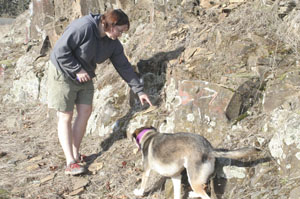 |
Lisa Chase and her dog search for one of her caches at Washburn butte.
|
 VIDEO: VIDEO:
|
Jim Buckley goes caching! |
 AUDIO: AUDIO:
|
Interview with Jim Buckley |
 SLIDESHOW: SLIDESHOW:
|
Pictures of Geocaching! |
|
Mark and Shawn Jones pulled their Ford truck onto the shoulder of
Highway 99W, just northwest of Junction City. Mark Jones quickly
studied
his GPS navigator.
"It's hidden across the road!" he told his wife.
They were frantically crossing the highway as another car parked
abruptly behind their truck. Another couple, Jerri and Russ
Sternburg, exited the second car but had to wait for a series of cars
to
zoom by before they could cross.
"He's going to find it all by himself!" complained Jerri as she
watched
Mark Jones already searching a bush near a large maple tree
across the highway.
By the time the Sternburgs had joined in the search, they heard Mark
whoop out an excited, "Found it!"
He pulled out a Tupperware bowl covered in camouflage tape that was
tucked near the base of the tree. Opening it with a smile, he
eagerly gazed inside at the treasure: a Pez candy dispenser, a plastic
necklace, a single Lego block and a log sheet scrawled with about 20 names
of people who had already found that container.
All in their 50s, the Joneses and Sternburgs have been avidly
pursuing geocaching, a casual form of treasure hunting based on
consumer handheld Global Positioning System (GPS) navigators. The
activity's basic premise is that one person hides a small container,
a "cache," and then posts the GPS coordinates online so that other
people can try and locate it. Most caches contain a collection of
cheap trinkets, but participants say that the real allure of hobby
is the thrill of hunting for caches that are cleverly tucked out
of sight.
These caches can be a receptacle of any size from a pen cap to a huge
10-gallon plastic jug. They are then hidden -- and often hidden very well
-- like camouflaged Easter eggs in nooks and crannies across America. The
most popular geocaching website, www.geocaching.com, says that there are over 350,000 caches
across the world on all seven continents, including Antarctica.
"A lot of times, people put caches in places of interest for
them -- their
favorite places," said Russ Sternburg.
"We have seen more cool places because of geocaching -- places that
we'd
never find on our own," added Jerri. "It's for everybody, from
3-year-olds to 90-year-olds."
The Sternburgs credit geocaching for giving them an incentive to travel all over the Northwest.
As they arrived back home after a successful tour of geocaching, the
Jones' noticed an unfamiliar SUV parked across the street.
Someone was looking for one of their caches, Shawn explained. The Joneses had placed a cache directly across the road from their house, and they could watch from their porch as geocachers tried to find it.
Walking over to chat, the Joneses met a much younger pair of 19-year-old
geocachers: Lorraine Pelkey of Junction City and Branden Hansen of
Harrisburg. They were rather new to the game, Hansen explained.
"We don't know all of the jargon quite yet." said Hansen. "But
it's a
lot of fun. There's a variety of things to do: you can go out into the
country, or into the city if you feel like it."
Mark Jones said that he and his wife had found approximately 450
caches. "But to have 400 to 500 is nothing special," said Mark.
"There's plenty of people who have found 4,000."
Everyone starts out geocaching the same way, said Mark. "First you do
it
with a friend. Then you do it on your own. Then you take it way too
seriously and get real competitive."
"It's not like there's anything special in the caches," said Lisa
Chase.
"But having caches gives people permission to get outside.
Chase, better known as "Odder" among the geocaching community,
has become one of the most prolific and well-known geocachers in
Oregon. She has hidden a multitude of caches in scenic and generally
unknown areas of Linn County. Chase said that she likes to place
her caches in high places, particularly areas where people who trek
to find her spots are treated to a good vista.
"If you make people work for it, they're likely to write poetic things in the log book," Chase said.
By her count, she currently has 379 caches, along with eight or nine that she says still remain unfound. An artist by trade, Chase often caches pieces of her artwork such as paintings, magnets, medallions and other knick-knacks.
Chase says she was introduced to geocaching from a news story on Oregon Public Broadcasting in March 2003. Her husband voiced an interest in trying it, so she bought him a GPS. They tried it out and found their first cache without any trouble.
"Okay, I'm done," Chase recalled her husband saying after his first find. But she was hooked.
Chase says that because of geocaching, she has received more business for her art and has become part of a close social group.
"We're a tight-knit group, but we're all kinda freaks," said Chase. "Who else would use $100 million satellites to locate Tupperware in the woods?"
| 



